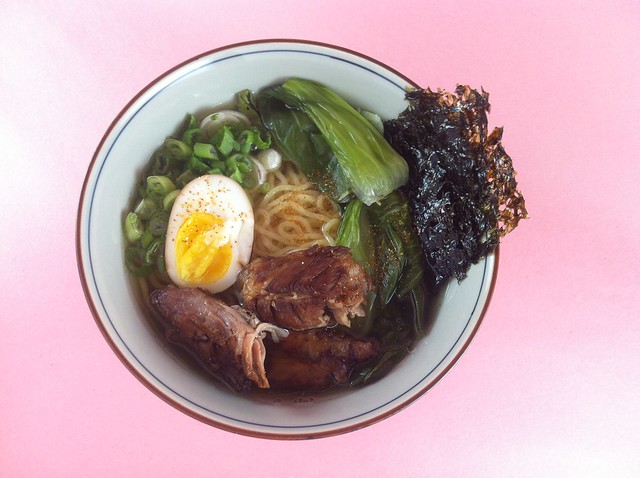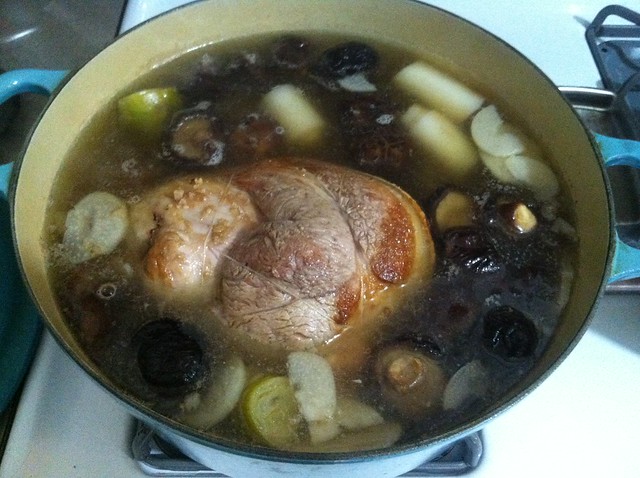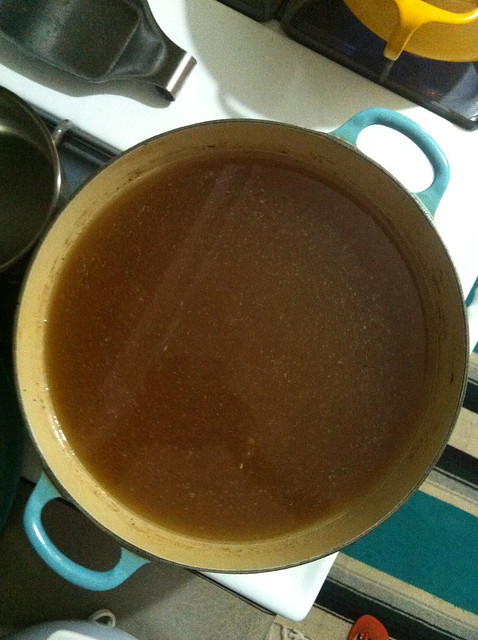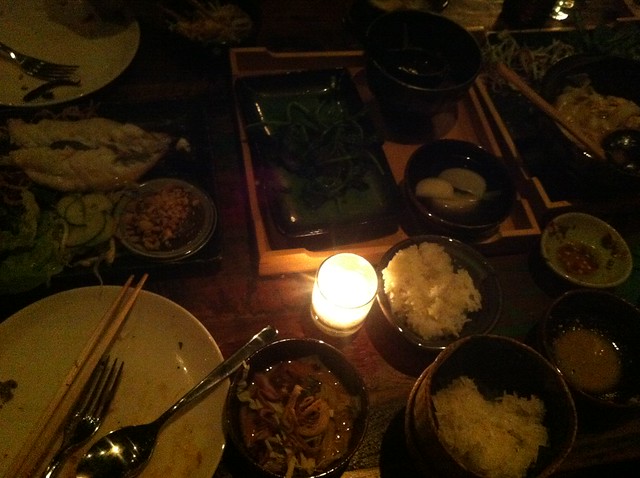I took a lot of liberties with this ramen broth recipe and took bits and pieces from both the Momofuku cookbook and the very detail-oriented Serious Eats blog entry. I combined both and made them work according to my schedule, so bear with me as you read through my narrative and the version of steps I took.
Ingredients:
For the broth:
2 pounds chicken necks and backs
1 rack of pork baby back ribs, separated
1 large leek, halved lengthwise
2 knobs fresh ginger, peeled and thinly sliced
4 garlic cloves, sliced
shoyu, or soy sauce
dried mushrooms
oil
1 pork shoulder butt, tied
salt
1 sheet of kombu, or dried kelpFor the ramen:
fresh chuka soba, or curly noodles
bok choy, rinsed and separated
4 eggs
shoyu, or soy sauce
mirin, or Japanese rice wine
2 scallions, chopped
2 sheets of nori, torn into smaller squares
togarashi, or Japanese red chile flakes
I made the chicken stock the day before because my Rottweiler, Atticus, is currently on a diet of plain boiled rice and chicken and I have a lot of broth handy at the moment. Doing the chicken stock ahead of time actually worked well because when I removed the pot of chicken broth from the fridge, it was so much easier to scoop out the fat that formed at the top and discard it.
1. Make the chicken stock. Boil a large pot of water with the chicken bones. Scoop out the impurities that float to the top and let simmer for an hour. Remove from heat and let cool before storing in the fridge.
The next day, which is the main cooking day, I made sure the chicken broth was out of the fridge and sat in room temperature, uncovered. Then I started to make the pork broth. I used my largest Dutch oven because the chicken broth was in my other pot.
2. Make the pork stock. Boil a large pot of water with the pork ribs. Scoop out the impurities that float to the top and let simmer for an hour.
3. While waiting for the water for the pork broth to boil, I browned the leek, ginger, and garlic in a large skillet over medium fire.
4. I also soaked the dried mushrooms in a bowl of water.
5. I then added the browned vegetables to the boiling pork broth with a cup of shoyu. I scooped out the impurities that rose to the top several times while doing the next steps.
6. Meanwhile, I tied up the pork butt, seasoned and rubbed it with salt, and browned it on all sides on the same large skillet over medium fire.
7. Then I added the browned pork butt and the drained mushrooms, plus the kombu, to the broth. I kept scooping out the impurities.
8. Whenever the broth looked like it was getting reduced, I added a batch of the chicken stock to mix the two kinds together.
The pork and the vegetables simmered for several hours, a total of about 6. I don’t know how comfortable you are about leaving the stove on, but I ran errands outside while I had the fire in its lowest setting and the pot uncovered.
9. An hour before I thought the broth was going to be done, I prepared the ramen toppings.
10. I boiled the eggs in boiling water: 5 minutes for a runny yolk. I let them cool before peeling them.
11. I soaked the eggs in equal parts shoyu-mirin mixture.
12. I steamed the bok choy in a separate pot for about 5 minutes.
13. I sliced scallions.
A note on the soaking of the eggs, by the way. The eggs will float to the top of the shoyu-mirin mixture and that’s why you see my eggs are unevenly colored. I didn’t realize that until it was ready to slice them in half, so take a small tea cup to keep them submerged when you do it.
This next step of separating the pork meat from the bones should be easy because the meat is well-cooked. Try to be gentle and don’t let the meat disintegrate. Your ramen presentation would look better with larger chunks of pork on top.
14. I removed the pork butt and the ribs from the broth onto a baking dish and let them rest. I then separated the meat from the pork butt bone and the rib bones.
15. I brushed the pork meat with shoyu and broiled them in the oven for 3 minutes to brown them.
16. I removed the vegetables from the broth using a slotted spoon and discarded them. I kept the fire at the very lowest setting to keep the broth warm. Every time a film of fat would form at the top, I scooped it out to try and keep the broth clean as much as possible.
My guests started coming in and that’s when I started to cook the ramen noodles. They were served beers and gin and tonics while they waited.
17. Cook the noodles in another pot of boiling water, about 10 minutes tops so that they’re al dente. When they are done, remove to a strainer. Do not rinse the noodles.
18. I assembled each ramen dish by dividing the cooked noodles among serving bowls and ladling a cup or two of broth into each one. I topped it with some bok choy. I drained the soaking eggs and cut them in half and put one half of it in each bowl. I added 2 pieces of pork meat, too. A small sheet of nori was tucked in and a smattering of scallions was added. Togarashi was served at the table with a bowl of shoyu-mirin mixture so each guest can adjust their own ramen bowl according to their taste.
And that’s that. It’s true that after all that time I spent making the broth that I felt more connected to the dish. I was proud to serve it and was very grateful when my guests appreciated the time and effort I put in.
Related post/s:
The Momofuku cookbook is always a good one to have
Serious Eats has a great Ramen Week page







